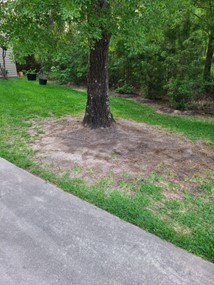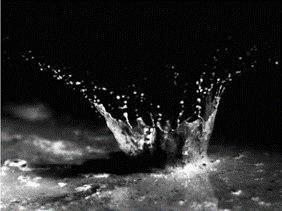 Being in this industry for the last 17 years, you can imagine that I’ve seen just about all the great (and mostly not so great) recommendations concerning the proper stabilization of a slope.
Being in this industry for the last 17 years, you can imagine that I’ve seen just about all the great (and mostly not so great) recommendations concerning the proper stabilization of a slope.
Now we’re talking about pond slopes here, and pond slopes are a little tricky for many reasons. We’ll get into that, but first, let’s talk about what we are trying to achieve, and then we can get into the challenges we face.
Slope stabilization is all about getting grasses, weeds, and native plants to grow on a slope. We’ll take any non-woody vegetation we can get, but we don’t want bushes and trees.
Trees and bushes will rob the soil of water and nutrients, stressing adjacent grasses and smaller vegetation.
 Additionally, the shade created by this larger growth will form a dead zone around the trunk and under the canopy that leaves soils exposed.
Additionally, the shade created by this larger growth will form a dead zone around the trunk and under the canopy that leaves soils exposed.
We definitely don’t want that because left exposed, the soil will wash away.
Understand that the reason we want these grasses in the first place is because the extensive root structures of grasses hold the soils, and hence the slope, in place.
This is why we welcome diversity in grasses and weeds as mentioned above; they provide differing root structures, some wide and spread out, some deep and thick, and everything in between.
The importance of this diversity becomes apparent during times of stress. We’re talking hot, dry summers here with long days and unforgivingly balmy nights. Imagine what would happen to your front lawn if you didn’t water it all summer long.
I can tell you from experience it’s not good! And I think it’s safe to assume that the vast majority of detention ponds don’t have irrigation. This adds to the importance of establishing a robust and healthy stand of grass in the first place.
We also have to contend with the slope itself, which comes with its own set of problems, most notably rain. With rain, we have two challenges; the first obvious and the second not so much;
1. Flow- The flow of rainwater down pond slopes has incredible erosive power. That isn’t a problem if the slope has adequate vegetation. But left exposed, soils on the slope will quickly erode, creating rills that must be fixed before moving forward.
But you can’t just fill these rills in with dirt and re-vegetate. The slopes will need to be regraded and adequately compacted. With typical heavy, short burst rain events like we see in Texas, this cycle of grade-stabilize-rain-rill-regrade can be repeated several times if improper stabilization techniques are employed. As you can see, this can get quite frustrating and equally expensive.
2.Draw Down- The design of detention ponds is to store rainwater for a prescribed period of time (usually 24-72 hrs). So the cycle of filling up and draining out the detention pond is part and parcel of its design. And depending on the amount of rain in any given event, these ponds will fill up and draw down several times a year.
When they do, the slopes become saturated, leaving the soil less stable. Additionally, the full pond experiences water pressure against the slopes that becomes negative pressure as water draws down, meaning the pond slopes are being pulled away.
So we can see the importance of quickly establishing a thick, strong stand of grass. But mother nature moves at her own speed; slow and steady. Since we can’t make the grass grow as quickly as we need it, we have to look elsewhere for “instant” stabilization.
There are many products and techniques designed to stabilize slopes, and as you probably guessed, some work better than others.
What Is Hydromulch?
Let’s start with hydromulch. This is an excellent place to start because almost every design specification for new construction prescribes “hydromulch” to stabilize the slopes. So what’s in hydromulch? Not much! Paper and green dye. That’s right, mulched recycled newspaper and green dye.
And by the way, the dye is only used as a marker so that the applicator knows where he has and hasn’t sprayed. Seed, fertilizer, and water are added to the mix and sprayed onto the slope.
 This mix works reasonably well on flat ground but is no match against rainwater flowing down the slope, bringing most of the hydromulch blend (including the seeds) to the pond’s floor.
This mix works reasonably well on flat ground but is no match against rainwater flowing down the slope, bringing most of the hydromulch blend (including the seeds) to the pond’s floor.
(This pond was sprayed with paper hydromulch. Soils have eroded to the point of needing to be regraded and stabilized…again!)
At this point, without any protection, the pond slopes begin to erode, with subsequent rain events only exacerbating the problem. Using recycled wood pulp mulch instead of paper is a step up but still does nothing to keep the material on the slope.
If we add a tackifier (fancy word for glue, usually guar gum), the chances of success at keeping the seed and fertilizer in place on the slope are greatly enhanced. Now we need to deal with the effects of raindrops on the soil.
The Effects Rain Has On Soil
 We all know how erosive water flow can be on streambanks and rivers, but did you know that raindrops hitting bare soil can be equally as erosive. An individual raindrop can disperse soil up to 3-5 ft, and a heavy rain event can splash up to 90 tons of soil per acre. In addition to rain flowing down the slope, we must mitigate the effect of those drops coming from the sky. The best way to do this is to introduce a barrier between the rain and the soil.
We all know how erosive water flow can be on streambanks and rivers, but did you know that raindrops hitting bare soil can be equally as erosive. An individual raindrop can disperse soil up to 3-5 ft, and a heavy rain event can splash up to 90 tons of soil per acre. In addition to rain flowing down the slope, we must mitigate the effect of those drops coming from the sky. The best way to do this is to introduce a barrier between the rain and the soil.
There are several ways to do this: straw mulch, erosion control blankets, and hydraulically applied products that look like traditional hydromulch but are, in reality, erosion control blankets applied like hydromulch. We’ll look at these in-depth in a future post, but remember that these products were created out of necessity because traditional hydromulch was never intended to stabilize slopes.
Suppose you choose to attempt slope stabilization with a traditional hydromulch mix. In that case, you may consider installing temporary irrigation to control the amount and frequency of your watering cycle.
And pray that we don’t get a hard rain before establishing vegetation on the slopes, which takes 7-30 days just to germinate!
What’s The Solution?
In Houston, and for that matter, Austin, San Antonio, and Dallas, we rarely go two weeks without rain.
Still, in reality, we need a month free of heavy rain and daily light watering if we have any chance of regular hydromulch providing a full stand of grass. Fat chance!
What it really boils down to is risk tolerance and price. The good news is that there are many products with varying performance expectations and respective price points, so the decision doesn’t have to be all or nothing.
We provide our customers a free soils report that gives us a detailed analysis of the soil conditions and any deficiencies that need correction before attempting any slope stabilization.
This blueprint helps us decide which options are viable and what you can expect with each one. Without knowing the soil conditions we are just guessing…and we don’t like to guess!
If you would like to discuss the various options including hydromulch for your situation please feel free to reach out to us.
We can conduct a complimentary site assessment and provide you with the soil report as mentioned above.
